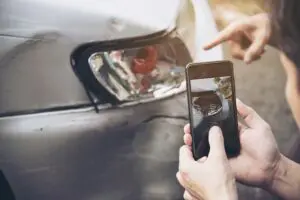In the wake of a car accident, it’s difficult to think clearly. There are injuries and property damages to deal with even as the world swirls from the shock of the impact. But what you do in the minutes after an accident can change the course of your physical and financial recovery.
First things first, get medical help for your injuries. If you need emergency services but aren’t well enough to call, have someone on the scene call for you.
If you are well enough to get up and around, start photographing the accident. This helps with the investigation and reconstruction of the accident and serves as a critical record for insurance and legal claims.

(jcomp/Freepik)
What If I’m Not Well Enough to Take Pictures?
If you aren’t up to taking photos, but you have a loved one on the scene, have them take pictures for you.
Why Photos Matter
Preserve Evidence
Photos serve as an immediate, time-stamped record of the accident before anything changes. If the scene is altered or cleaned up before an investigation is completed (e.g., vehicles are moved), photographic evidence can help preserve critical details.
Substantiate Insurance Claims
Insurance companies often require clear evidence to assess fault and damages. Photos of the damage to vehicles, the location, and any visible injuries can help support your version of events when filing claims. Without them, insurers may rely solely on the police report, which might not reflect all the facts.
Clarify Disputes
There may be disagreements between drivers about what happened. One party may claim that the police report is inaccurate or incomplete. Photos can help resolve these disputes by providing clear, objective visual evidence.
Support Your Legal Case
If the accident leads to a lawsuit, photos of the damages and injuries can serve as powerful evidence. Courts may rely on visual documentation to help understand the sequence of events or determine liability.
Demonstrate Severity
Sometimes, the extent of injuries and property damages may only become clear after the fact, but photos can help verify the connection between the wreck and its effects. For example, your car damages may seem minor until the body shop has a chance to look at your vehicle. They may tell you that the accident bent the frame of your car or caused fluid leaks that are costly to repair. Your photos can help show how these damages may have occurred.
When it comes to physical damages, insurance companies are famous for trying to pin your injuries on pre-existing health problems. Photos can help show that your injuries were a direct result of the accident.
Corroborate Witness Testimonies
If there are any witnesses to the accident, their statements may not always be fully reliable or complete. Photos can act as a neutral third-party account of what happened, helping corroborate witness testimonies or counter false claims.
Can’t I Rely on the Police Report?
You should always call the police after an accident, even a minor one, as their report is vital for your insurance claim. However, you shouldn’t rely strictly on the police force to capture all the visual evidence of your wreck. While police officers are trained to do accurate and thorough work, no one is perfect.
Your photos can reflect a comprehensive, accurate, and unbiased record of the situation, including injuries, vehicle damage, road conditions, traffic signs, skid marks, and the surrounding environment. These images can be indispensable for insurance claims and legal cases, especially if the police report had errors or omissions.
What Photos Should I Take?
Here’s a checklist to help you capture all of the important shots:
Driver/Vehicle Information
Photograph the other driver’s license plate. With their permission, get a photo of their driver’s license and insurance information.
The Broad View
Capture the whole accident scene from a wide angle. For context, make sure to include both vehicles, street signs and signals, damages to surrounding infrastructure (like guardrails or poles), and weather conditions (like heavy rain or snow).
Damage to Vehicles
Get close-up shots of any dents and scratches. Don’t ignore the interior damage (such as deployed airbags, broken glass, etc.)
Injuries
If the driver or passenger sustained visible wounds or cuts, photograph them.
The Road
Photograph the road conditions, road blocks or debris, and any skid marks.
A Few Tips:
- Look around to see if there are security cameras in the area. Take a picture of them and talk to your attorney about getting photos or videos from the operators.
- Try not to move anything as you take your photos so you don’t obstruct evidence.
Should I Take Videos?
While photographs are powerful, videos can be even better for certain things. These include:
- Bad weather (such as snowfall, sleet, or rain).
- Witness testimonies (if they are willing to be recorded).
- Context of the accident scene. When you pan the scene, you can capture more context than you can with a single snapshot.
- Driver behavior. Is the other driver acting erratic or agitated? Are they drunk or profane? Footage of the other driver can help your case. If you get their consent, recording is permissible. If not, recording is generally OK in a public place, but an attorney can help.
Whether you’re dealing with the insurance company or filing a personal injury legal case, photographs and videos provide compelling evidence. Seeing is believing, so it’s worth pulling out your phone to capture the important details or getting a trusted source to assist you.
